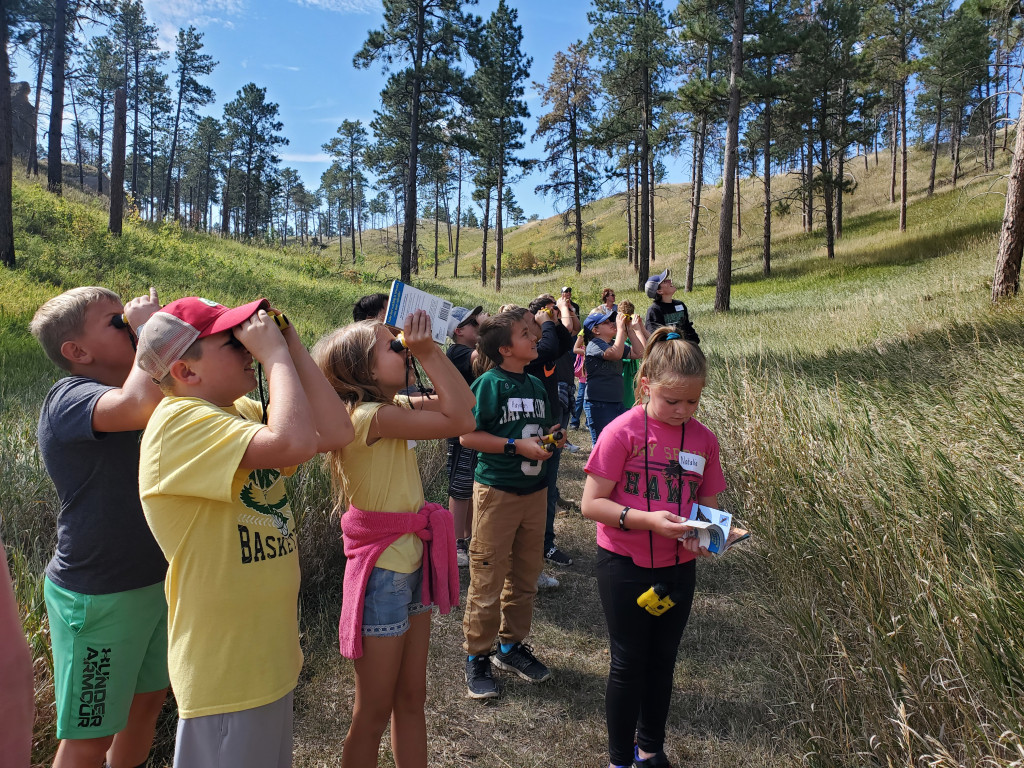Enlarge

Photo by Laura Smedsrud
By: Delanie Bruce, Education Manager, Bird Conservancy of the Rockies & Nebraska Game and Parks Commission
Wildcat Hills State Recreation Area and Chadron State Park saw a lot of birds this fall migration season. Over the seven-week period, Aug. 24-Oct. 15, 2022, staff banded nearly 700 song birds between the two stations: 165 birds at Chadron and 527 birds at Wildcat Hills.
Bird banding is the process of capturing wild birds and placing a uniquely numbered band around one leg before releasing them back into the wild. After each bird receives its aluminum accessory, the “bander” records the following information: species, age, sex, wing and tail measurements, fat presence, molt (replacement of feathers) and weight.

The primary reason for banding birds is to tell individuals apart, and through future recaptures, learn more about an individual’s migratory routes; how wintering, breeding, and stopover spots connect; as well as habitat preferences. In certain situations, evaluating an individual’s body condition can tell us whether stopover spots had plenty of food or if the bird struggled on its journey due to limited resources or natural disasters, such as wildfires. Ultimately, by examining this data, we may be able to see changes in bird populations over time, one example being the timing of migration due to climate change.
Delayed migration can increase competition among bird species, since some birds may stay in their breeding grounds longer, which will reduce the amount of resources left for other birds migrating through that area. This creates a domino effect that could threaten the ability of North American migratory songbirds to successfully mate, raise healthy offspring and survive. Information gathered from bird banding will help scientists better address the challenges that face migratory birds in a changing world.

2022 Banding Overview
In late August 2022, we knew Wildcat Hills was going to see another busy year when the first two mornings of banding yielded over 100 birds. Of the 38 species of birds banded at the SRA, the most common included the black-capped chickadee, house finch and Gambel’s white-crowned sparrow. Special visitors included the Baltimore x Bullock’s hybrid — a first for the Wildcat Hills station, Tennessee warblers, a pink-sided junco and a Townsend’s warbler. It was a great year for Townsend’s solitaires, with nine individuals banded. We banded 527 birds in total at Wildcat Hills.
Chadron had the lowest bird year since 2012, at only 165 newly banded birds. Factors that may have hindered numbers included the extreme heat into late September, rough winds throughout the season and the lack of habitat maturity since the 2012 fire at Chadron State Park. Of the 34 species of birds banded, the most common included the black-capped chickadee, house wren and orange-crowned warbler. “Rarest” species include American redstart, indigo bunting, Townsend’s solitaire and willow flycatcher.

Connecting Students to Bird Science
The banding stations at Wildcat Hills and Chadron are operated and funded through a partnership between Bird Conservancy of the Rockies, the Nebraska Game and Parks Commission and the Nebraska Environmental Trust. While the scientific goal of these two bird banding stations is to gather data, the stations also have been essential in building broader support for bird conservation among Nebraskans across the Panhandle.
At these banding stations, hands-on activities and interactive experiences have promoted science literacy among students and provided opportunities to connect with nature. And with scientists working on site, visitors are offered views of what research looks like, hopefully creating new career connections among aspiring students. Between Wildcat Hills SRA and Chadron SP, 400 students and adults visited in 2022. Our staff looks forward to bird banding next year and continually sharing the important work that is being done for birds in the Nebraska Panhandle.
Bird Conservancy of the Rockies is eternally grateful for the continual support of the banding stations from the Nebraska Game and Parks Commission, Nebraska Environmental Trust Fund, and Paul and Bea Sauer.

History of Bird Banding in the Panhandle
The Wildcat Hills State Recreation Area banding station began operation in 2007, while the Chadron State Park station began in 2008, each running every fall season since. The surrounding habitat of both Wildcat Hills and Chadron are quite different from much of Nebraska. Wildcat Hills features rocky escarpments with ponderosa pines, junipers and a mountain mahogany understory. Annual banding totals at Wildcat Hills are dominated by seedeaters, such as sparrows and finches. While at Chadron, annual banding totals are dominated by mostly insect-eaters, such as wrens and warblers. As you might expect, habitat plays a major role in the species composition of banded birds at any banding station.

The post Bird Banding in the Panhandle appeared first on Nebraskaland Magazine.
















